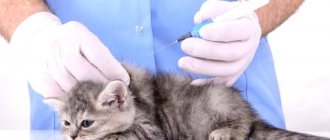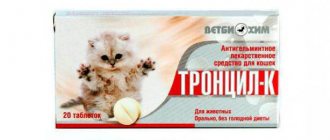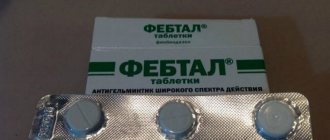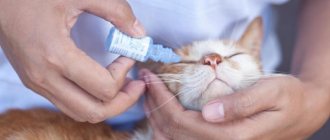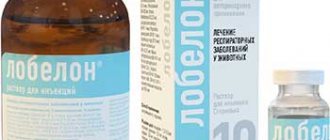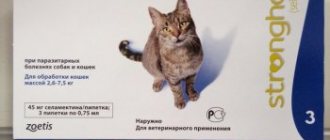Pets are not immune to stomach and intestinal problems. They, like people, vomit. A special drug, Cerucal, can relieve an attack of vomiting and nausea. This medicine is suitable for humans and animals. Cerucal for cats is often prescribed by veterinarians if your furry pet is sick.
Owners should not worry if their cat vomits a hairball. This is a normal physiological process. Cats are clean animals, they often lick themselves. Hairs remain on the rough tongue. The wool enters the stomach, but is not digested. They accumulate there. As a result, the hairball comes out naturally - with feces or vomit. The frequency of hair vomiting varies by breed. If cats have a chic long coat, then a similar natural process can be observed up to twice a month. If the cat is smooth-haired, then the owners may notice hairballs coming out with vomiting no more than several times every six months. Pharmacies sell special hair removal pastes that make it easier to remove accumulated hair from the stomach.
It's another matter if the cat vomits frequently. This may be a symptom of an illness. You need to contact a specialist. An experienced veterinarian will examine your furry pet and prescribe the necessary treatment. It is not uncommon for Cerucal to be included in the list of medications that help in the treatment of various disorders.
Composition of the drug
The composition of the drug includes main and auxiliary components.
The main (i.e. active) compound is metoclopramide hydrochloride monohydrate:
- It has a pronounced antiemetic effect.
- Initially, metoclopramide was used by doctors to treat migraines, i.e. the substance is capable of blocking spastic attacks of pain.
- Accelerates the removal of semi-digested food from the stomach into the small intestine, without causing diarrhea (but there are nuances, which we will discuss below).
The following are used as auxiliary components (depending on the dosage form):
- Starch.
- Milk sugar (lactose).
- Gelatin.
- Silicon, magnesium and sodium compounds (including regular sodium chloride).
- Additional purified water for injection is used as the basis for the liquid dosage form.
Optimal storage conditions
Since the medicine is quite strong (but is considered safe), the storage conditions recommended by the manufacturer must be followed exactly:
- The temperature should be maintained between 0° and 25°C. The liquid dosage form is stored at a temperature from 0° to 4°C (preferably in this range). It is not advisable to freeze the drug, but the manufacturer himself states that a single cycle of freezing and thawing does not affect the therapeutic properties of Cerucal in any way.
- It is very important to isolate the storage location from direct sunlight, since ultraviolet radiation has an extremely detrimental effect on the active ingredients of the medicine and quickly renders the latter unusable.
- Since uncontrolled use of this product is fraught with unpredictable consequences, it is necessary to store it in a place where it is guaranteed that pets and small children will not get into it.
Indications for use of Cerucal
Veterinarians identify the following indications for use:
- Nausea and vomiting of various etiologies.
- Atony of the upper gastrointestinal tract, including the period of postoperative recovery.
- Esophagitis (inflammation of the esophagus), accompanied by vomiting.
- Impaired contractility of the gallbladder and ducts (dyskenesia).
- Narrowing of the lumen of the pylorus of the stomach (this is characterized by vomiting soon after eating).
- Gastric atony in cats with diabetes.
- Oddly enough, but the medicine perfectly helps cats that are unbearably sick in transport.
- In cases where the pet is prescribed some medications, the use of which may be accompanied by vomiting.
- The drug is prescribed before fluoroscopic examination of the stomach, immediately after the administration of contrast agents. In this case, the medicine accelerates peristalsis, as a result of which the contrast agent is quickly and evenly distributed along the entire length of the digestive tract.
- The medicine has also proven itself well as a “sedative” prescribed before a stomach examination. In this case, the upper part of the organ relaxes, making it much easier to insert the probe.
- The medicine helps animals after severe injuries resulting in a concussion (with this pathology, cats vomit violently and constantly).
Analogues of the product
The most well-known analogues of Cerucal for cats are the following medications;
- Metalclopromide, also available in tablet and solution form. It differs in price and effectiveness. However, if you overdose, your cat may experience serious health problems.
- Tseruglan. Produced in Germany and is considered an ideal analog product. In addition, you can replace Cerucal with Metamol, Granaton, Motin, Motilium Passazhiks, Dompiredon, Veracol.
Poor guy
How does Cerucal work on a cat?
The mechanism of action of Cerucal is based on blocking serotonin and dopamine receptors in the brain.
The active substance of the medicine, i.e. Metoclopramide acts very selectively, and therefore there are usually no other consequences of using the drug:
- Due to the blocking of the corresponding receptors in the animal, the sensitivity threshold of the vomiting center (which is also located in the brain) sharply increases.
- The animal's feeling of nausea disappears.
- Appetite returns.
- The cat no longer vomits after eating.
- The tone of the pet's lower stomach and sphincter improves, which helps improve overall intestinal motility. This has a beneficial effect on the process of digestion of food and the general condition of the animal.
- The synthesis of bile and its release into the lumen of the duodenum is normalized. This effect of Cerucal allows some veterinarians to use it as a means to prevent cholecystitis.
- The medicine promotes the synthesis of prolactin and improves the process of milk secretion and release.
The active substance is actively processed in the liver and 50% is eliminated from the cat’s body within 5 hours. But! It must be remembered that in cats with kidney pathologies, the therapeutic concentration of the drug in the blood can remain for almost 28 hours.
Instructions for use of Cerucal tablets
Let us emphasize once again that the instructions we offer for the use of Cerucal in tablets are given, rather, “for show,” since under normal conditions this medicine is not given to cats in the form of pills. It's difficult to dose.
The tablet form is usually given by force: the tablet is placed on the root of the cat's tongue and, while performing a throat massage, the medicine is swallowed. The hand is drawn from the lower jaw along the throat to the sternum. This technique allows you to achieve better manifestation of the swallowing reflex.
If the cat stubbornly does not want to eat the “treat,” the tablet must be crushed to a powder state and then mixed with water to form a thick paste. It is smeared on the root of the cat's tongue, after which the pet will simply be forced to eat the medicine.
Dosage and method of administration
When prescribing Cerucal for cats, the dosage should be determined by the doctor. The veterinarian prescribes a treatment regimen and dosage of medication based on the facts he knows about the animal. Among them: age, weight, existing diseases, general health and others.
It is usually allowed to give your pet Cerucal 2-3 times a day. In this case, the dose of Cerucal for cats is calculated at 0.4 mg per kilogram of weight. Tablets of the drug are available in 10 mg doses. A cat weighing 5 kg will need to take a little less than a quarter of a whole tablet. Ampoule volume 2 ml.
The drug works best when taken on an empty stomach. A piece of the tablet is given to the pet 30 minutes before meals. First, the cat is wrapped in a towel to limit its movements. The animal must be held in such a way that its head is slightly raised. A tablet is placed in the open mouth closer to the root of the tongue. The mouth is closed and held closed until the cat swallows the medicine. The swallowing reflex can be triggered by blowing into the cat's nose. Next, the owner must calm the pet, give him something tasty, and pour fresh water into a bowl.
If a solution is used, the drug can be injected either into a vein or intramuscularly.
How and where to inject a cat correctly when using liquid Cerucal
Here's how to correctly and where to inject your cat when using the injectable form of the medicine:
- The drug can only be administered intramuscularly and intravenously.
- The best place for intramuscular injection is the gluteal muscle area. Many blood vessels pass through these places, and therefore the administered drug is quickly absorbed and distributed throughout the animal’s body.
- Intravenous injections are made by selecting the veins running along the inside of the front legs. This place is good because the blood vessels are close to the skin, and the skin itself is thin and delicate, the filled vein is very easy to palpate.
Regardless of the specific injection method, the medicine is administered gradually, without rushing. The drug should be distributed evenly and gradually throughout the tissues.
Reviews of “Cerucal” for cats
Many cat lovers have encountered such a problem as vomiting in a tailed cat. Some of these people left comments about the treatment of the animal with Cerucal. Here's what cat owners say: the medicine helps quickly, after just a week you can finish the diet and go back to your usual diet without worrying that your stomach simply won't accept the food. Convenient form of release - tablets are easy to give, but not every animal is able to swallow an unpleasant drug. None of those who wrote noted any side effects.
Dosage of the drug and signs of drug overdose in cats
The described dosage of the drug and signs of overdose are given as indicative. Under no circumstances should you prescribe or use medicine on your own, as this can lead to very serious consequences!
You need to remember one important nuance - this medicine is not for veterinary use. Initially, it was developed and created exclusively for medicine, and only then veterinarians “refined” the methods of using Cerucal in their practice.
When using the medicine in tablets, 0.5-0.7 mg of active substance for every 10 kg of animal weight. Considering that the tablet contains 10 mg of metoclopramide hydrochloride, it is simply impossible to adequately dose the drug in this case.
Release forms of Cerucal for dogs
The manufacturer provides two forms of release of Cerucal for dogs - injection solution and tablets. Both varieties are used in all dog breeds, but are prescribed by veterinarians for different indications.
Injection solution
To stop incessant vomiting, injections of the drug are prescribed, since the tablets in such a physiological state will not have time to be absorbed by the body. 1 ml of 0.5% injection solution of Cerucal contains 5 mg of the active substance Metoclopramide hydrochloride and auxiliary raw materials - sodium sulfite - 0.125 mg; disodium edetate - 0.4 mg; sodium chloride - 8 mg; water for injection - 991.705 mg. The liquid preparation is packaged in 2 ml ampoules made of transparent glass with colored rings applied.
The injection form of Cerucal is supplied to pharmacies in factory-made cardboard packages containing 10 ampoules of the drug and instructions.
Pills
The tablet form of Cerucal is convenient to use in the treatment of pathologies of the gastrointestinal tract and in preparing dogs for examinations. Cerucal tablets for dogs contain 10 mg of metoclopramide hydrochloride and excipients: potato starch - 36.75 mg; lactose monohydrate - 76.65 mg; gelatin - 2.16 mg; silicon dioxide - 2.6 mg; magnesium stearate - 1.3 mg. Tablets are packed in 50 pcs. in brown glass bottles sealed with a white stopper.
The cardboard packaging of the tablet form of Cerucal contains one bottle and instructions for use of the drug.
Side effects after taking Cerucal
The following side effects are possible:
- The animal exhibits vomiting and diarrhea.
- Various nervous system disorders, including irritability. Some pets develop causeless, uncontrolled aggression.
- The cat's heart rate increases and blood pressure increases. If the animal initially suffers from hypertension, this can lead to the death of the pet.
- The cat may become overly apathetic, and in some cases there may be serious depression.
- Tremors (shaking) and strong, involuntary contractions of skeletal muscles are possible.
- Some pets experience intense hypersalivation (excessive saliva is produced).
Contraindications
There are the following contraindications:
- The drug is strictly forbidden to be given to pregnant cats.
- Giving medicine to nursing cats is equally strictly prohibited. As we have already written, the components of the medicine easily pass into breast milk.
- The drug must not be used to treat animals under at least nine months of age. Neglecting this rule can lead to toxic liver damage.
- Treatment is carried out under constant veterinary supervision if the cat has tumors or is suspected of cancer.
- In case of exacerbation of chronic diseases (of any etiology), the drug is also prescribed with caution.
Side effects
If the doses of Cerucal are exceeded or if the cat is individually intolerant to the components of the drug, side effects may occur.:
- dizziness, confusion, tinnitus;
- anxiety, feeling of fear (the cat may hide under objects or hide in a corner);
- changes in blood pressure, tachycardia;
- diarrhea or constipation;
- hormonal imbalances;
- allergic reaction.
If the owner is planning a cat pregnancy in the near future, then he should skip at least 1 hunt after finishing using the drug.
© shutterstock
